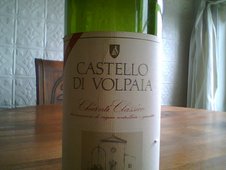
Joseph Bastianich's wines may be the most visible wines from Friuli in New York, owing to the man's standing as a restauranteur. The man co-owns, with chef Mario Batali, Babbo, Del Posto, Esca and Otto, among others. At each and every one of these eateries you'll find Bastianich's wines well featured on the wine list, with his flagship bottle, Vespa Bianco, the most well represented.
At the Nov. 4 meeting of the Wine Media Guild, Bastianich treated the assembled to a vertical tasting of his Vespa Bianco, beginning at the beginning, with 2001 and running up to the current vintage, 2007, with only 2003 and 2005 missing in action. It was amusing to see Joseph there at Felidia, where the WMG always meets, because the restaurant belongs to his mother, Lidia Bastianich, who showed herself a true mother by watching over and praising her young. Also on hand was Lidia's daughter, Tanya, an Italian art history expert. It was a family affair.
Vespa Biano is what Joe called his "field blend," patterned after blended wines from the family's native Friuli, in northeast Italy. It's primarily a mix of Sauvignon Blanc and Chardonnay, with some Picolit thrown in. The grapes are vinified separately in both steel and oak, and left for almost a year on the lees. The wine is then bottle-aged for another year and a half.
Now, I adore Friulian wines. But to be honest, Bastianich is my fallback. I like the line in general, particularly the 100% Fruilano, but I don't find in them as much depth of character as I do in the work of my favorite Friuli winemakers, such as Gravner, Villa Russiz and Schiopetto. Still, it's respectable wine, and certainly worthy of a examination like this.
I found the bottle I liked best first off: the 2001. It was aging nicely. There was little fruit left, mainly some lime and kumquat. It was the diesel and metallic characteristics the shone most brightly, plus a little not unwelcome oxidation. Joe told me he felt the wine could age 10 more years. The crowd favorite, meanwhile, was the 2004. Not surprisingly, it was a warmer, rounder wine, the flavors of lemon and lime, even if the nose was shut down a bit.
The 2002 was from a wet year. It was more muted than 2001, but had good acidity, some metallic notes, and nice lemon and lime. 2006 was softer and almost watery, with succelent lime and gooseberry notes. I felt the Chardonnay was showing more strongly. Joe called it more "showy" than the other wines. And 2007, which is out now, had the most aromatic nose, full and fruity. The palate was soft, with flavors of lime, tropical fruit and flowers. Here, the Sauvignon was most forward. It's still a young wine, though.
We also tasted two Tocai Plus wine, 2003 and 2005, which I felt had a great deal more personality. These are made from 100% Friulano, and are much more interesting as food partners.




